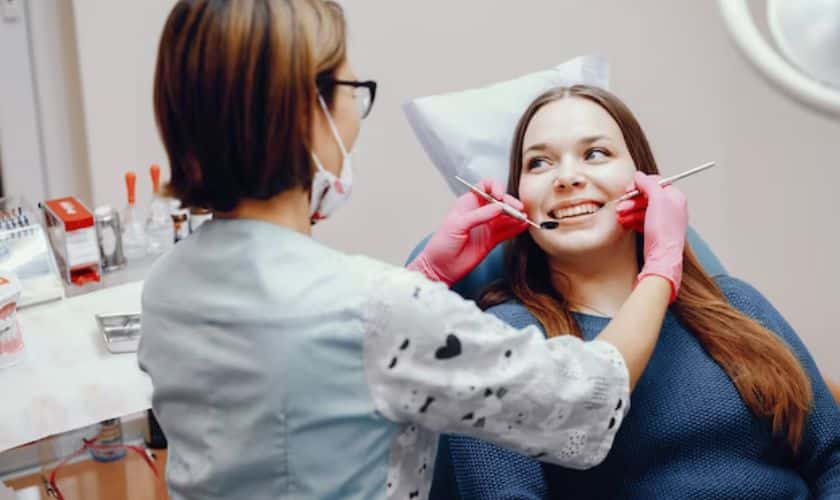Pearl Dental Blog

Is Your Tooth Too Damaged to Save?
Our teeth are incredibly strong, but they aren’t invincible. Chipped from an errant olive pit, cracked under the pressure of biting down on ice, or slowly weakened by decay – teeth can sustain damage through everyday wear and tear, accidents, or neglect. If you’re facing a compromised tooth, the question inevitably arises: is it too far gone, or can it be saved?
The good news is that dentists prioritize saving your natural teeth whenever possible. Natural teeth have a unique ability to integrate seamlessly with your jawbone and surrounding tissues, promoting optimal oral health and function. However, there are some situations where extraction becomes the best course of action. Let’s delve into the factors a dentist considers when determining if a tooth can be salvaged.
The Extent of the Damage:
- Cracks and Fractures: Small chips or cracks on the enamel (outer tooth layer) can often be repaired with bonding, a tooth-colored resin that fills in the chipped area. However, deeper cracks that extend to the dentin (inner layer) or reach below the gum line might necessitate a crown, a tooth-shaped cap that encases the entire tooth for added support. If the crack compromises too much tooth structure, extraction might be necessary.
- Cavities: Early detection and treatment of cavities with fillings are straightforward procedures. However, extensive decay that reaches the pulp (the innermost chamber containing nerves and blood vessels) necessitates a root canal. During this procedure, the infected pulp is removed, the canals are cleaned and disinfected, and the tooth is sealed with a filling or crown. In very severe cases where the infection spreads beyond the tooth or the tooth structure is severely compromised, extraction might be unavoidable.
- Infection: A hallmark sign of an infected tooth is a throbbing pain that may radiate to the jaw or ear. In such cases, a root canal is usually the first line of defense. However, if the infection spreads to the bone (abscess), antibiotics might be needed alongside a root canal or, in severe cases, extraction.
The Root System:
A healthy root system is paramount for anchoring the tooth in the jawbone and providing stability for chewing. If the root is damaged due to trauma, severe infection, or gum disease, the tooth might become loose and non-functional. In such scenarios, extraction might be the best option.
Overall Oral Health:
Sometimes, saving a single tooth might not be in your best long-term oral health interest. For instance, an impacted wisdom tooth that crowds surrounding teeth, causing misalignment or infection, might be better off extracted to prevent further complications.
Your Symptoms:
Pain, sensitivity, swelling, or difficulty chewing are all crucial indicators of the severity of the damage. While some discomfort might be manageable with treatment, persistent or severe pain suggests a more serious issue that might necessitate extraction.
Diagnosis and Treatment Options:
Only a dentist can definitively determine the fate of your tooth. Through a thorough examination, X-rays, and other diagnostic tools, they can assess the extent of the damage, the health of the root system, and the surrounding bone. Based on this evaluation, they will discuss your treatment options, which might include fillings, crowns, root canals, or extraction. They will also detail the risks and benefits of each option, allowing you to make an informed decision about your oral health.
When Extraction Might Be Necessary:
While dentists strive to save natural teeth, there are some instances where extraction becomes the most appropriate course of action. These include:
- Severely cracked or fractured teeth that cannot be adequately restored with a crown.
- Extensive decay that leaves insufficient healthy tooth structure for a filling or crown.
- Deep infection that has spread to the jawbone.
- Impacted wisdom teeth causing pain or misalignment.
- Teeth with significant bone loss due to gum disease.
Living With a Missing Tooth
Modern dentistry offers excellent solutions to replace missing teeth and restore oral function and aesthetics. These options include:
- Dental Implants: These are small titanium posts surgically implanted into the jawbone to act as artificial tooth roots. Crowns, bridges, or dentures can then be attached to the implants, providing a stable and natural-looking replacement for missing teeth.
- Dental Bridges: These bridge the gap between missing teeth with crowns attached to the healthy teeth on either side of the gap.
- Dentures: These removable appliances replace entire arches of missing teeth.
Looking For A Dentist in Culver City
If you’re concerned about a damaged tooth, seeking professional dental care in Culver City. Early intervention can often prevent the need for extraction and ensure a more straightforward and cost-effective treatment process. At Pearl Dental Culver City





